
Rotatable Sputtering Targets - Performance Comparison of Silver Sleeved Rotary Targets with Planar Targets
1 /
6Pages
Catalog excerpts
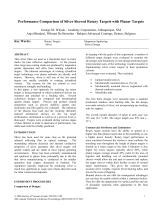
Key Words: Rotary Targets Magnetron Sputtering Sleeve Design ABSTRACT Thin silver films are used as a functional layer in many stacks for heat reflective applications. At the present time, large area coating stacks are produced by magnetron sputter deposition and often from rotating cylindrical targets. The inherent advantages of rotating cylindrical target technology over planar cathodes are already well known. However, silver is still one of the few metal targets not readily available in rotating cylindrical version. The reasons for this are related to cost, mechanical strength, and handling. In this paper, a new approach for realizing Ag rotary targets is being proposed in which cylindrical sleeves are mounted and attached on a backing tube. Several cylindrical designs are compared and benchmarked against planar targets. Process and product related parameters such as process stability, sputter rate, uniformity and film quality are evaluated. The influence of the plasma heat load and the resulting thermally induced mechanical stresses on the Ag target performance, mechanical as well as on a process level, is discussed. Targets were evaluated during various stages of their lifetime in order to determine if performance was stable and could be reliably predicted. INTRODUCTION Silver has been used for some time as the principal infrared reflecting film in optical coatings. The outstanding inherent electrical and thermal conductive properties of silver guarantee that silver targets will sputter readily and are stable in most typical operating environments. Silver has been primarily manufactured and sputtered in planar form, principally due to the fact that silver manufacturing is conducted in far smaller quantities than copper, aluminum or titanium. The equipment typically employed for producing silver is much less significant in scope and volume than that used for other commercial materials. EXPERIMENT PROCEDURES Comparison of Designs In keeping with the goals of this experiment, a number of different target designs were evaluated to examine the advantages and limitations of each design predicated upon what potential users of the technology would encounter in implementing silver rotary targets in their production systems. Four designs were evaluated. They included: • Indium bonded sleeves • Mechanically mounted sleeves augmented with thermal conductive paste • Monolithic tube The first three designs were mounted upon a standard production stainless steel backing tube, the last design was made entirely of silver, not incorporating any backing tube for support. The overall outside diameter of target in each case was 155 mm (6.1”) OD. The target length was 878 mm (~ 35”). Commercial Attributes and Limitations Rotary target systems have the ability to sputter at a higher rate than planar targets due to the possibility to use a higher power density. Rotary target performance is more consistent because the erosion is more uniform, the trenching seen throughout the length of planar targets is limited on a rotary target to the ends. Utilization is also higher for rotary targets, typically above 80%, while planar targets average around 30% yield. In the area of logistics and handling, use of mechanically mounted sleeves would allow the end user to remove and replace the target sleeves within their facility as part of normal target maintenance. This gives the customer more accurate silver weights, requires fewer backing tubes, and lowers the costs of shipping. Bonded sleeves do not offer the management advantages nor can they be readily rebuilt within a customer facility. They do offer the opportunity for surface profiles and use of dissimilar materials when appropriate to the final application. © 2006 Society of Vacuum Coaters 505/856-7188 49th Annual Technical Conference Proceedings (2005) ISSN 0737-5921
Open the catalog to page 1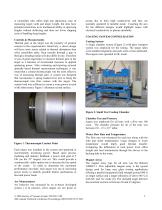
A monolithic tube offers high rate deposition, ease of measuring target yield and target weight, but does have potential restrictions in its mechanical ability to span long lengths without deflecting and does not lower shipping costs of handling long lengths. arcing due to their high conductivity and they are normally sputtered in metallic mode. Counting the arcs for the different designs would highlight issues with electrical conductivity or plasma instability. COATING SYSTEM CONFIGURATION Controls & Measurements Thermal gain in the target was the property of greatest concern to the...
Open the catalog to page 2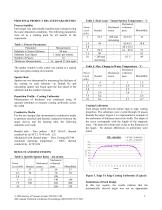
PROCESS & PRODUCT RELATED PARAMETERS Process Stability Each target was individually installed and evaluated using the same deposition conditions. The following parameters were set as a starting point for all aspects of the experiment. Table 1. Process Parameters © 2006 Society of Vacuum Coaters 505/856-7188 49th Annual Technical Conference Proceedings (2005) ISSN 0737-5921 Figure 3. Edge To Edge Coating Uniformity (Typical) Limitations of Each Design In this test regime, the results indicate that the mechanically sleeved target was not an appropriate
Open the catalog to page 3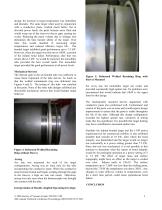
design, the increase in target temperature was immediate and dramatic. The same target when used in conjunction with a conductive paste, worked much better, but at elevated power loads, the paste became more fluid and would weep out of the sleeve-to-sleeve gaps causing arc events. Reducing the paste volume due to leakage also diminishes the heat transfer ability of the target. Over time, this would manifest in increasing target temperatures and reduced effective target life. The bonded target exhibited good performance up to 7.5 kW. However, when the target was first run to 10kW, a portion...
Open the catalog to page 4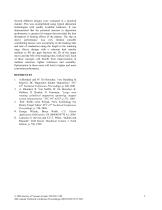
Several different designs were evaluated in a practical manner. This was accomplished using typical deposition technologies with readily available hardware. It was demonstrated that the potential increase in deposition performance is greatest for targets that provided the best dissipation of heating effects of the plasma. The slip on sleeve performance was very limited, possible contributing factors were eccentricity in the backing tube and lack of conduction along the length to the retaining rings. Sleeve designs with a coherent heat transfer medium to fill the gaps between the ID of the...
Open the catalog to page 5All Materion Brush Ltd catalogs and technical brochures
-
BatteryMaterials
2 Pages
-
Engineered Films
4 Pages
-
W-Ti Sputtering Targets
2 Pages
-
Thermotech TE Vacuum Paste
1 Pages
-
Sputtering Targets11
4 Pages
-
Silvertech Epoxy
1 Pages
-
Semiconductor Materials
4 Pages
-
MEMS Materials
4 Pages
-
EMI Shielding Materials
2 Pages
-
CIGS
1 Pages
-
Evaporation Materials
4 Pages
-
EVAPro Gold
2 Pages
-
C95510
2 Pages
-
Alloy 10X
2 Pages
-
BRUSH® 1916
2 Pages
-
BRUSH® 1915
2 Pages























